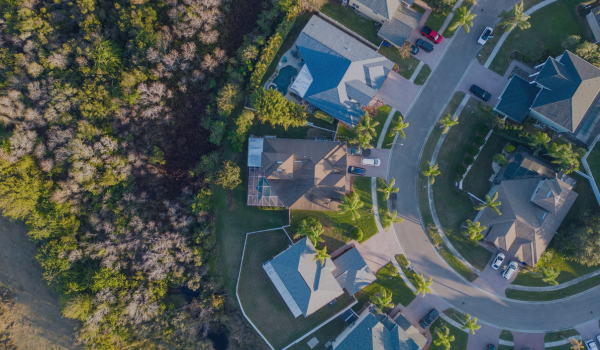You may not know it, but your home insurance premiums are the result of complex calculations.
Insurance companies consider many different factors, from the condition of your home to your payment history. Some of those factors are within your control as a homeowner and others are not.
Here are some of the most important factors to consider when shopping for homeowner’s insurance, along with what you can do to keep your premiums as low as possible.
1. Deductible
A deductible is the amount you pay out-of-pocket before your insurance company will pay anything on a claim.
For example, if you have a $2,000 loss and a $500 deductible, you’ll pay $500 and the insurance company will pay the remaining $1,500 — assuming the claim is approved.
Deductibles usually apply only to property damage and not to liability claims. If someone gets injured on your property and sues, your deductible wouldn’t count against covered costs.
Most home insurance policies have a minimum deductible. If you choose a higher deductible, you’ll typically get lower rates, but you’ll pay more if you file a claim.
2. Age of Home
Older homes may be more expensive to insure because they typically cost more to rebuild. The construction materials, like hardwood flooring or wall plaster, are more expensive and more difficult to acquire.
If you own or are considering buying an older home, you can offset the increased insurance cost by updating systems like plumbing, electrical, and heating. Newer versions of these systems cost less to replace, reduce your overall insurance risk, and won’t change the aesthetics of a historic home.
3. Roof
Insurance companies pay special attention to the condition of your roof when determining your insurance rates. An older or damaged roof increases your vulnerability to storm and water damage, so an insurance company is likely to charge you more. Upgrading that old roof may qualify you for an insurance discount that can help offset the cost of replacement.
4. Home Security
According to the Insurance Information Institute, you can save up to 5% just by installing a burglar alarm, smoke detector, or deadbolt locks. If your alarm system alerts local emergency responders, or if you upgrade your fire protection system to add sprinklers, you can save as much as 20%, depending on your insurance company
Different companies have different requirements for home security and fire protection systems. Before you invest in a system, check with your insurance company to find out how much you could save.
5. Public Protection Class
Insurance companies also calculate your home’s fire risk using the Insurance Services Office’s Public Protection Classification System. The system uses factors like fire department quality, water supply system, and fire alarm systems to score a community’s fire response system on a score of 1 to 10. Lower scores mean that it’s easier for firefighters to get to your home, and that may mean lower rates.
6. Proximity to the Coast
Coastal areas are at higher risk of hurricanes and windstorms. If you live near the ocean, your insurance company may require you to carry a separate hurricane deductible.
Homes near the coast also have a higher risk of flooding. Flood insurance is excluded from most standard homeowner’s policies, so you’ll have to purchase a separate policy.
7. Swimming Pool
A pool in your yard increases your liability risk. In the summer of 2017 alone, at least 163 children under 15 died from drowning in pools or spas. Nearly 70% were under age 5.
Because the potential for loss is so high, the Insurance Information Institute recommends that all pool owners increase their liability coverage to at least $300,000. That extra coverage is important, but it will drive up your insurance premiums.
A swimming pool is also expensive to replace. That can also increase your premiums because it increases the overall cost of rebuilding your home.
If you don’t want to get rid of your pool, you might be able to mitigate the additional cost by installing safety measures. Install a secure fence around your pool so that no one can swim — or fall in — without your knowing about it, and definitely don’t install a diving board. It’ll drive your rates up even more.
8. Dogs
In 2019, there were 17,802 dog bite claims filed nationwide, costing homeowners $797 million. The average cost per claim is also going up, so it’s no wonder that insurance companies can be wary of covering aggressive pets or breeds.
Some insurance companies avoid insuring people with certain “aggressive” breeds, like Pit Bulls or German Shepherds. Others make decisions based on the individual dog and whether it has a history of biting.
Regardless of breed, if a dog bites someone, an insurance company will consider the dog to be more of a liability and may increase the owner’s premiums or remove the dog from the policy. Some will reinstate coverage if the dog completes behavior training or is physically restrained.
9. Insurance Score and Credit History
In most states, insurance companies can use your insurance score and/or credit history to determine your homeowner’s insurance rates. Your credit score tells a company how likely you are to pay your premiums on time. Your insurance score predicts whether the company will take a loss by insuring you.
Both scores are calculated based on your personal borrowing history— debts, repayment history, number of accounts in use, and so on. That makes this one of the easiest cost factors to control. By paying your credit card balances off every month, avoiding defaults, and staying out of bankruptcy, you can control your home insurance rates.
Key Takeaways
Educating yourself about your homeowner’s insurance rates makes you a more informed consumer. It lets you shop around more effectively and choose the right amount of coverage for your needs.
If you have questions about your home insurance rates, contact RMC today for a free homeowner’s quote.



